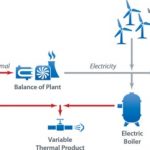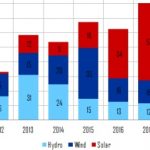Many industries – production of steel, aluminium and cement being the most obvious – require high heat processes that today can only be achieved commercially using fossil fuels. Paige Bennett at EcoWatch, writing for WEF, describes a new process using solar thermal trapping to reach temperatures of a little over 1,000°C, hot enough to smelt metal. Scientists used semi-transparent materials, including synthetic quartz, to capture sunlight that … [Read more...]
New Concentrated Solar Power system delivers 1,000°C for industrial processes + more
Zach Winn at MIT describes a new method of building high-temperature concentrated solar power systems. The solar receiver heats air to around 1,000°C at atmospheric pressure. The system circulates the hot air with no combustion or emissions to drive a turbine. The system can deliver daytime power and overnight thermal energy storage to provide round-the-clock power. More interestingly, it can provide industrial-grade heat. It’s being … [Read more...]
Thermal Energy Storage for heating and cooling Buildings: finding materials that melt at room temperature
Thermal Energy Storage (TES) in individual buildings can cut heating and cooling costs while delivering grid stability, explains Ryan Horns writing for NREL. Back in the 1800s blocks of ice were shipped to cities to cool buildings down. Today, research is underway to identify materials that can be heated or cooled by excess grid power and release or absorb heat when needed. Similarly, materials are being researched and developed that “phase … [Read more...]
Long-duration storage: mechanical, electrochemical, thermal. We’ll need all three
“Long-duration” means the amount of time a power system can discharge electricity (this is different from long-term storage, i.e. the amount of time a system can store energy before discharging it). As Maria Chavez at UCS explains, it’s vital to the success of intermittent wind and solar roll-out which needs to store its excess generation for when it’s needed. And as electrification grows it will provide greater grid flexibility and resilience … [Read more...]
New thermophotovoltaic cells turn heat into electricity more efficiently than a steam turbine
Over 90% of the world’s electricity comes from heat-generating power plants using coal, natural gas, nuclear energy, and concentrated solar energy. Steam turbines have always been the standard for converting that heat into electricity. On average they are only 35% efficient, with moving parts that cannot cope with temperatures above 2,000 degrees Celsius. Jennifer Chu at MIT describes new research, in collaboration with NREL, that has led to a … [Read more...]
China should comfortably meet its 2030 Renewables target. But its emissions?
The long Covid lockdown seems to have had little effect on China’s electricity generation growth. In 2021, total generation increased by about 750 TWh (that’s around 1.3 times Germany's absolute total). Solar PV capacity grew by 53 GW last year (equal to the total installed solar capacity in Germany). Half of all offshore wind turbines installed worldwide in 2021 were off the coast of China: the strong additions were accelerated by the January … [Read more...]
Intelligent, flexible Sector Coupling in cities can double the potential for Wind and Solar
This week the European Commission tabled the Energy Performance of Buildings Directive (EPBD) which should accelerate the decarbonisation of buildings. Buildings and cities play a key role in the energy transition. And the target high shares of variable renewable power supply will be much more easily achieved if the sectors using them display demand flexibility. In essence, that means using or storing the excess wind and solar generation … [Read more...]
Nuclear-Wind hybrid plants for grid stability, Power-to-X and more
How would you use a nuclear-wind hybrid plant and maximise its potential? When intermittent wind’s output falls, nuclear can step in to feed the grid. When it’s not doing that it can use its power to run the production of a wide range of commodities: from biofuels, hydrogen, pumped hydro to wastewater purification, desalination, chemical manufacturing and more – including straightforward thermal power for industry. In collaboration with NREL, the … [Read more...]
China’s 2019 electricity generation reviewed as its next 5-year plan is drafted
Simon Göss breaks down the totals and additions for electricity generation in China. In 2019 the total reached 7,325 TWh (more than twice Europe’s) after adding 330 TWh (more than half Germany’s total). Of that 330 TWh, 120 TWh came from thermal (90%+ coal). But the numbers were dominated by renewables (hydro, wind, solar) which added almost 160 TWh. Though that’s the third year of declining renewables additions, wind and solar curtailment is … [Read more...]










